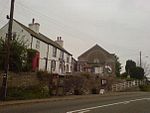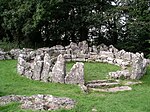St Michael's Church, Penrhoslligwy
15th-century church buildings in WalesGrade II* listed churches in AngleseyUnited Kingdom Anglican church building stubsWelsh building and structure stubs

St Michael's Church is the parish church of Penrhoslligwy, a village near Moelfre in the north-east of the island of Anglesey, in Gwynedd, Wales. With datable components from around 1400, the building is listed at Grade II* and was restored in 1865. (Penrhoslligwy is also sometimes written Penrhos Lligwy or Penrhos-Lligwy; the spelling Penrhoslligwy is used by the Church in Wales.)
Excerpt from the Wikipedia article St Michael's Church, Penrhoslligwy (License: CC BY-SA 3.0, Authors, Images).St Michael's Church, Penrhoslligwy
A5025,
Geographical coordinates (GPS) Address External links Nearby Places Show on map
Geographical coordinates (GPS)
| Latitude | Longitude |
|---|---|
| N 53.3483 ° | E -4.2841 ° |
Address
St Michael's Church
A5025
LL70 9PX , Moelfre
Wales, United Kingdom
Open on Google Maps









